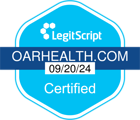Does Harm Reduction Really Make a Difference?

In This Article
The term “harm reduction” gets mentioned frequently in content about substance use, addiction, and recovery. But what does it really mean?
Harm reduction is a public health term. It involves strategies that help reduce harm around alcohol and drug use. Laws against drunk driving are a key example. While the term can feel kind of abstract and impersonal, at its root, the concept is truly about the individual.
“Harm reduction is really about the autonomy for people to choose based on their own goals and preferences,” says Geoff Bathje, PhD, a professor at Adler University and a psychologist at Sana Healing Collective.
Let’s look a little deeper at the concept of harm reduction and how it’s rooted in choice.
A quick history of harm reduction
“Harm reduction” as a term was introduced in the 1980s with the first safe needle exchange programs for people who inject drugs. These programs have helped reduce the spread of HIV (1).
We often hear of harm reduction now in the context of supervised injection facilities or access to naloxone (Narcan) to reverse opioid overdoses. Both have been shown to help keep people safer. But harm reduction is a common concept for alcohol use too (2, 3).
“I think it’s easy to take for granted how common harm reduction is when it comes to alcohol,” Bathje says, “just because it’s a legal drug, and it’s much more culturally acceptable to have open conversations about the risks and how to prevent them.”
One of the most successful harm reduction programs ever, Bathje adds, has been the “Friends Don’t Let Friends Drive Drunk” campaign.
“We don't say you can’t drive a car or you can’t ever drink,” he explains. “We just say don’t combine those. And so that’s harm reduction.”
The Ad Council, in partnership with the National Highway Traffic Safety Administration, launched the well-known drunk driving prevention campaign in 1983. But harm reduction dates back much further.
We have safe substance use spaces for alcohol, too, like bars with rules and restrictions, Bathje explains. And we have quality control measures in place for how alcohol is manufactured that prevent people from being poisoned (4).
“I think a lot of public health messaging around alcohol is more reality-based and harm reduction-oriented,” Bathje says, “than our fear-based and abstinence-oriented approaches to other substances.”
Harm reduction isn’t just about moderation vs. abstinence
Harm reduction strategies also exist in the context of treatment, recovery, or changing personal behaviors associated with alcohol or other substance use. But harm reduction doesn’t come down to a hard line between moderation and abstinence.
The topic of moderation — drinking or using another drug less — is often associated or linked with the concept of harm reduction. And certainly moderation is a type of harm reduction. But so is abstinence.
“The only difference is that abstinence is harm reduction when the person has chosen it voluntarily for themselves,” Bathje says.
Harm reduction as treatment
One example of harm reduction used in the context of treatment is the concept of Motivational Interviewing (MI) (5).
“You don’t impose a goal on the client,” Bathje explains. “You work with clients differently based on their level of motivation to change. If somebody is only motivated to drink in a safer context, and not drive, that would be an acceptable goal.”
More than 91% of people with alcohol use disorder (AUD) who are seeking treatment want to reduce consumption or have better control over their drinking rather than abstain from alcohol completely, research shows (6).
Oar Health’s national research supports this view. It found that people at severe risk of AUD are 12 times more likely to prefer moderation (i.e., reducing consumption) than quitting.
MI is rooted in what’s called Stages of Change Theory. The concept involves five stages. The fourth stage is the action stage, when someone is actively making a change, and the fifth stage is the maintenance stage (7).
“Our entire [national alcohol] treatment system is built as if everyone is in the action stage — that they’re ready to take action and make changes right away,” Bathje says. “But the data says maybe 20% of people who have substance use disorder are ready to choose abstinence or attempt abstinence.”
When it comes to AUD, we need more alternatives to abstinence, with abstinence remaining a key option, Bathje adds, including for people who’ve previously chosen moderation.
That is what harm reduction is all about: giving people choices. So while some people are looking for a strategy to quit drinking, others are looking for alternatives to abstinence-only programs like Alcoholics Anonymous and still others are looking for support that may be specific to their situation, such as support for veterans looking to cut-back or quit drinking.
“One thing we find in research is that people are just as likely to end up abstinent if they start with a moderation goal, than if they start with an abstinence goal,” Bathje says.
Going straight to an abstinence goal doesn’t make abstinence more likely to stick, especially if that’s not where someone’s motivation is.
“You might be able to engage people in treatment earlier by going with whatever their current goals are,” Bathje adds.
Supervised injection facilities are a key example of this. These sites have increased access to and use of treatment centers, detoxification programs, and therapies that help treat addiction, research shows (8).
Takeaway
Harm reduction, although a bit of a clinical term, is really about giving people a menu of options when it comes to making positive changes surrounding substance use.
“What we need to consider is that we can make a difference,” Bathje says. “We can help people be safer, regardless of their level of substance use.”
About The Author
Jennifer Chesak is a freelance medical journalist, editor, and fact-checker with more than two decades of experience and bylines in several national publications. Follow her @jenchesak.





